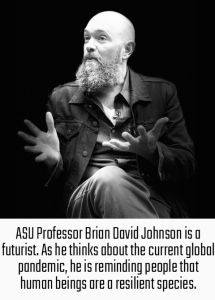Forward thinking: ASU futurist looks to the past to see what’s next in the COVID-19 crisis

Brian David Johnson spends his days thinking about the future. In today’s uncertain times, he is being called upon more to talk about what happens next — after the shelter-in-place orders. Johnson is a futurist. He teaches at Arizona State University and runs a threatcasting lab. The Portland, Oregon, resident also works with government agencies and companies as a consultant. He got started in this field when was at chipmaker Intel Corp. He is quick to point out that he is not a virologist, he is not a doctor, he is not an economist and he is not a first responder.
 “People need to hear about the future and that it’s going to be OK,” he said. “My job is to help people think about the future and give them the tools and give them perspectives to think about the future. What I can do for people is help people think about what comes after the pandemic.”
“People need to hear about the future and that it’s going to be OK,” he said. “My job is to help people think about the future and give them the tools and give them perspectives to think about the future. What I can do for people is help people think about what comes after the pandemic.”
How should business owners be thinking about their own stabilization?
The destabilization shows weakness in your business, in your social networks, in the broader ecosystem. So start thinking about what you need to do as we move back to this new normal to fix it and make it better, to create redundancies. We might not have another pandemic in the next one, two or 10 years but we know we’re going to have another major destabilizing event. Here, we know we’re going to have a large earthquake on the West Coast, that’s also a destabilizing event.
How do we move on?
Human beings don’t give themselves enough credit. We are incredibly adaptive. I tell my students, back in the time of saber-tooth tigers, we weren’t bigger. Humans weren’t faster, we didn’t have claws. But what we can do that the saber-tooth tiger couldn’t do is we could adapt. Much like after the lockdown that happened after September 11, we will go back to a level of normalcy but it won’t be the same one that we had back in December 2019.
